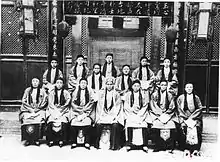Lin Hei'er | |
|---|---|
林黑兒 | |
 Lin Hei'er and leaders of the Red Lantern Unit | |
| Born | 1871 |
| Died | ca 1900 |
| Nationality | Chinese |
| Occupation | Rebel |
| Organization | Red Lantern |
| Title | Holy Mother of the Yellow Lotus |
| Spouse | Li Youchuan |
Lin Hei'er (Chinese: 林黑兒; 1871[1] – 1900?) was a Chinese rebel during the Boxer Rebellion, known as the Holy Mother of the Yellow Lotus (Chinese: 黃蓮聖母).[1] She was a prostitute and acrobat with martial arts knowledge who became a member of the Yihetuan. During the Boxer Rebellion, she organized and commanded the Red Lantern unit of female soldiers in Tianjin.
Life
Born on a Tianjin canal houseboat, Lin studied acrobatics and earned a living as an itinerant entertainer with her father.[2] She married Li Youchuan while still very young. Li Youchuan was arrested by British soldiers during a raid against the opium trade and died in prison.[1] Later, she became a prostitute in Houjia, on the south bank of the South Canal in the Hongqiao District, Tianjin.[1] Furious against foreigners because of the death of Li Youchuan,[2] Hei'er joined the rebels of the Yihetuan. Once trained in martial arts, she trained female recruits and founded the Red Lantern Unit of young female soldiers, the name coming from the color of their clothes. With rebel's widows she formed the Blue Lantern Unit and with the old women, the Black Lantern Unit. In addition she formed the Pan Lantern Unit of cooks who were in charge of feeding the rebel troops. She recruited prostitutes, beggars and peasants into her ranks and rejected well-to-do women as useless "lotus feet".[1]
In July 1900, the combined force of the Eight-Nation Alliance descended on Beijing and Tianjin and looted and pillaged the cities.[3][4] Lin Hei'er and other leaders put up fierce resistance.[5] Lin Hei'er was injured during the Battle of Tientsin and was captured along with the other leaders on July 14, 1900, when the imperial troops who secretly helped the rebels abandoned them to their fate.[6] Her final destination is unknown.[5] Probably she was tried and executed, although turned into a popular heroine, the popular songs proclaimed that she survived.[6]
A monument in her honor, the Red Lantern monument, was erected in 1994 near her place of birth.[1]
See also
References
- 1 2 3 4 5 6 Hagen, C. S. (7 December 2013). "Red Lanterns Rising". C S News. Retrieved 13 January 2019.
- 1 2 Lee, Lau & Stefanowska 2015, p. 131.
- ↑ O'Connor 1973, Chap. 16.
- ↑ Hevia 2007.
- 1 2 Lee, Lau & Stefanowska 2015, p. 132.
- 1 2 "Lin Hei'er - head of the Red Lantern Unit - ColorQ Articles Etc". www.colorq.org. Retrieved 13 January 2019.
Bibliography
- Hevia, James L (2007). "Looting and its discontents: Moral discourse and the plunder of Beijing, 1900–1901". In Bickers, Robert; Tiedemann, R. G. (eds.). The Boxers, China, and the World. Rowman & Littlefield Publishers. ISBN 9780742571976.
- Lee, Lily Xiao Hong; Lau, Clara; Stefanowska, A. D. (2015). Biographical Dictionary of Chinese Women: v. 1: The Qing Period, 1644-1911. Routledge. ISBN 9781317475880.
- O'Connor, Richard (1973). The Boxer Rebellion. Hale. ISBN 9780709147800.